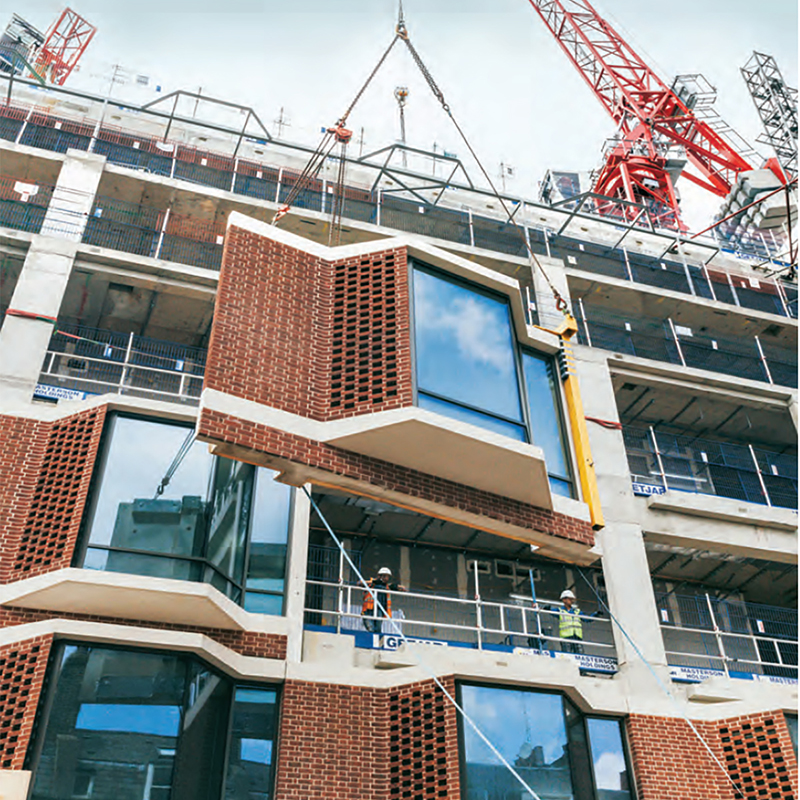Stefan Trifonov, Head of Engineering at Schüco UK, in conversation with Architecture Today’s Technical Editor John Ramshaw, discusses how modern methods of construction (MMC) are being used to optimise Schüco’s latest generation of unitised curtain wall systems.
In association with![]()
UCLH, London, by BMJ Architects and Pillbrow & Partners. The project employs Schüco FWS 50 curtain walling and AWS 70.HI windows (photo: Peter Cook)
Prefabrication and offsite production have had a long and chequered history within the construction industry. But new thinking and rapid technological developments driven by modern methods of construction (MMC) are beginning to usher in a new age of building better, quicker, safer, cheaper, and more sustainably. For some manufacturers, MMC are also facilitating a ‘mass customisation’ approach to building systems, resulting in greater choice and design freedom for architects and their clients.
One company at the forefront of this technological revolution is façade, window and doors systems manufacturer Schüco. Stefan Trifonov PhD, Head of Engineering at Schüco UK, in conversation with Architecture Today’s Technical Editor John Ramshaw, discusses how the company is using MMC to optimise and enhance its unitised curtain wall façade systems.
Prefabricated facade bays under construction in the factory
How important are MMC to Schüco and the development of new products in general?
The benefits of MMC – namely quality, cost, environmental impact, and health and safety – are so extensive that they have become the central pillar on which our innovation and manufacturing strategy is built. They’re a fundamental aspect of any product we produce, and we’ve dedicated significant resources to developing systems that utilise off-site fabrication and the digital infrastructure that supports this. The latter is particularly important in terms of streamlining component manufacture, traceability, and delivery to site.
How is Schüco applying MMC to its unitised curtain walling systems?
Schüco takes a bespoke and holistic approach to unitised curtain walling. Our solutions are tailor-made to each individual project, rather than assembled from a ‘manual’ or whatever products are available. We can create a new system for each new building, which allows us produce lean, efficient designs that combine performance with aesthetics.
If you – the specifier – are relying on standard, off-the-shelf components, the resulting façade is likely to be over engineered. For example, structural calculations may indicate the need for 125mm-deep profiles, but the choice of off-the-shelf components could be limited to 100mm or 150mm-deep sections. Clearly you would have to size-up to 150mm, which means that the façade would be over engineered by 25 per cent with all the environmental, cost and spatial impacts that this entails. Ultimately, we want to democratise unitised facades, so they are available to every building and design team.
UCLH facade under construction. The specialist contractor was Fleetwood Architectural Aluminium
What technologies or innovations is Schüco employing to ensure that it can offer freedom of design and manufacturing flexibility?
That’s a good question, and I’m not sure if there’s a simple answer to it. Alongside our state-of-the-art digital design and fabrication services, we rely on a team of highly qualified and experienced engineers, as well as many years of invaluable company knowledge and know-how. We certainly don’t have a secret technology that nobody else has! It’s about combining traditional skills and knowledge with new advances
in manufacturing and supply.
Until relatively recently, a unitised façade essentially meant some kind of ‘glass box’ featuring a lot of repetitive elements, rendered in a relatively flat and uniform way. Today, Schüco is able to manufacture and supply systems that incorporate an array of different materials, which are all carefully integrated into the same façade package. For example, we produce unitised chassis that can combine glass with other types of cladding, such as terracotta or stone. These types of system can also incorporate very large spans, as well as special corner units, among other elements. Ultimately, this all comes back to Schüco’s investment in and commitment to MMC.
Schüco unitised curtain walling under construction at Spencer Place in Dublin
Alongside aesthetics, what others benefits does this approach provide?
A façade that has been predominantly produced in a factory will inevitably be of better quality than one that has been put together on site. This is particularly important on complex facades featuring multiple materials and numerous junctions and intersections. MMC, including offsite fabrication, ensure improved consistency and predictability across the whole project. Design teams can therefore be more confident at the outset about what the end result is likely to be. Other benefits include reduced wastage and time savings on site.
Spencer Place, Dublin. Alucraft Systems was the specialist facade contractor
What further developments can we expect from Schüco in the near future?
The company’s commitment to unitised façade systems is such that it will no longer focus predominantly on off-the-shelf systems that can be sourced from a catalogue. Furthermore, instead of producing large, complex systems, which can take years to develop, we will be adopting a ‘building block’ methodology consisting of extremely robust and well-engineered components that can be incorporated into bespoke unitised façade designs enhancing their overall performance. This will allow us to be even more agile and flexible in meeting the needs of specifiers’ needs.
Overall, this approach plays to Schüco’s skills base and excellence in engineering, while also echoing the company ethos: ‘Our passion is outstanding buildings.’
Contact Details
For more information please call 01908 282111, email or visit the Schüco website.
Source: Architecture Today






